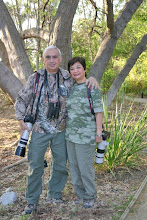We arrived at Bentsen-Rio National Wildlife Refuge just as the local guides were herding a group of birders for their Saturday morning bird walk. "Bird walk" would be a slight misnomer because the birders were actually taking a tram. We realized soon enough that the refuge was so huge that a vehicle would be needed to get around. That morning, there were too many birders to be accommodated in the tram. Our just-in-time appearance made it even worse. So they decided to use the park van to transport the spill-overs.
Each stop that we made had blinds near the feeders so that birders and photographers alike can view the birds without disturbing them. We had very good looks at the colorful South Texas birds such Green Jays, Altamira Orioles, Golden-fronted Woodpeckers, Cardinals and Kiskadees. American Goldfinches, Gnatcatchers and Warblers were all over the trees.
There were also a couple of mammalian sightings at the feeders: A javelina (a wild pig) and a raccoon.
Our guides, Jerry and Carol were very helpful in pointing out the park birds to us. At the aptly named Kingfisher pond, Jerry was able to locate a Ringed Kingfisher through his spotting scope. He graciously offered me to look at my first lifer of the day and 20th overall. Again, thanks to Jerry, he pointed out lifer number 21 - a Yellow-bellied Sapsucker looking for insects high up a tree. The tour ended at around 10:30 am and after locating the Allen's Hummingbird (everybody was quite excited with this Texas rarity, although quite common in California) near the Visitor's Center, we hied off to Anzalduas City Park.
Anzalduas City Park was a total dud bird-wise. Except for a flock of American Pipits which we saw as we were leaving, there was nothing of interest there. We got an Armadillo though.
We had a so-so Mexican lunch at Stripes - the convenience store associated with Valero's gas stations. From there we went to Edinburg Scenic Wetlands. There were a lot of people visiting the park that afternoon - not many of them birders. The northern lake is the home of a huge flock of Black-bellied Whistling Ducks. We've seen them in flight at Harlingen but never had any good looks. A small pond between the northern and southern lakes was supposed to be the home of the Green Kingfisher. Our first passover didn't reveal any.
We debated whether we should go visit Santa Ana Wildlife Refuge a few miles from here. But the day is getting late and we still have not seen our Green Kingfisher which the park attendant assured us was always there. As we were returning to the lakes, some birders from Wisconsin informed us that the kingfishers regularly come back to the pond and we'll just have to be patient. Along the way, I noticed an unusually colored warbler flit from tree to tree. With my binoculars I discovered that it was a Yellow-throated Warbler, lifer number 22.

We returned to the the pond and waited vigilantly for our target bird. And just as promised, a our lifer number 23 flew in. It settled across the pond from us where we had very good looks at it.
At some point while Cynthia was still eyeing the kingfisher, I noticed something yellow fly to a nearby clump of bushes. My heart leapt as I quickly took potshots at an Audubon's Oriole lifer number 24!
Satisfied that we got a good number of lifers today, Cynthia requested that we go back to the northern pond because she wanted to take flight shots of the Black-bellied Whistling Ducks. Besides the sun finally broke through and we hoped we could now get better photographs. Unfortunately the ducks didn't cooperate much.
Reluctantly we left and prepared ourselves for the long drive back to Brownsville.






.jpg)



No comments:
Post a Comment